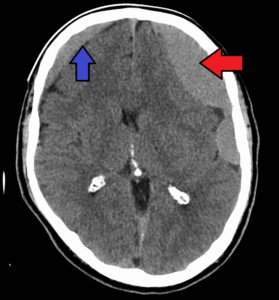
The more fit your brain is, the less likely you’ll get a brain bleed from slipping on ice and hitting your head hard on the concrete.
So the question then is, “How do we make our brain as fit as possible?”
I slipped and fell on a sheet of ice in my parents’ driveway. It happened so fast that I couldn’t react fast enough to prevent the back of my head from slamming into the concrete.
I immediately bounced back up, infuriated that this just happened, and quickly walked into the garage.
My head hit the concrete so hard that I considered the possibility of an acute subdural hematoma (brain bleed). The acute timeframe is up to three days from the incident.
Symptoms could kick in immediately or be delayed for six hours, 12, 24 or 72 hours.
Oddly enough — there was no pain. In fact, I began realizing my body and head felt as though I hadn’t even fallen, save for a little wetness on the left side of my hip and back from the ice and snow.
I was feeling quite normal, but knew that brain bleeds indeed could be delayed.
“In cases where a person seems perfectly fine after a head injury, we must keep in mind that there is a condition called lucid interval,” says Sashini Seeni, MD, a family medicine practitioner with DoctorOnCall, an online doctor and pharmacy.
“Lucid interval is the period of time when the patient seems fine after a head injury before becoming unconscious.”
My mother had blacked out due to low blood pressure several years prior in the bathroom and hit her head as she fell — on the bathtub.
It took six weeks for the brain bleed (chronic subdural hematoma) symptoms to begin presenting.

Subdural hematomas. James Heilman, MD
She was elderly. But chronic subdural hematomas (at least three weeks out from an accident) CAN occur in middle-aged people.
The subacute timeframe is between three days and three weeks out.
That very evening of my fall, the whiplash soreness – very sore — in my neck began setting in.
This really concerned me, because it suggested that my head must have really snapped back and hit the concrete hard.
However, I never developed any neurological problems (other than mild headaches on 10 separate days over a five week post-fall period).
I kept thinking of how this exact same fall would have killed an elderly person.
The primary care physician whom I saw six days post-fall told me that a brain bleed of the chronic subdural hematoma type in middle age people is exceedingly rare.
I know my head took the brunt of the fall. There had been only a few mild bruises on my left hip side.
My wrists and tailbone weren’t even affected. My butt didn’t have a single mark.
What Scared Younger Adults Who Hit Their Head Must Know
Shutterstock/Pixel-Shot
“In a patient with a head injury, the main concern is to detect intracranial hematoma, which is the collection of blood inside the skull caused by a ruptured blood vessel,” says Dr. Seeni.
“Over time, the amount of blood will increase and cause an increase in the intracranial pressure that leads to damage of the brain tissue.
“If a person does not show any immediate sign and symptoms after a head injury, look for any physical, emotional and mental changes.
“Intracranial hematoma can occur minutes or hours after a head injury.”
A chronic subdural hematoma (cSDH) is “predominantly a disease of the elderly,” says the Postgraduate Medical Journal (J 2002;78:71–75).
But if you’re middle aged or younger, and you’re worried sick that you’re going to have a brain bleed in the near future because you banged your head in the house somewhere, you need to know HOW a delayed brain bleed (cSDH) occurs in the elderly.
The Journal explains: “With aging, the mass of the brain decreases leading to an increase in the space between the brain and skull.
“This causes stretching of the bridging veins, and the greater movement of the brain within the cranium makes these veins vulnerable to trauma.”
To put this simply, when an old person gets banged in the head, there’s room for their aged, shrunken brain to shake around against the skull.
This jarring tears the veins between the brain and the skull.
The tears are very small (very slow bleeding), which is why, in a chronic SDH, symptoms take several weeks to start showing.
What about younger adults who DO die from brain bleeds?

Shutterstock/Corepics VOF
This kind of brain bleed beneath the dura mater is an “acute” subdural hematoma.
The Journal states: “Acute subdural haematomas generally occur in younger adults, after a major trauma, often associated with structural brain injury, and present within 72 hours.”
The key words here are “major trauma.”
If you, a middle age or younger adult, recently banged your head into the car door frame, or bonked your head on a table ledge after getting up from the floor … this doesn’t qualify as “major trauma.”
Other Examples of Non-Major Hits to the Head
• Accidentally walking into a closed glass door, thinking it was open (this happened to me; the glass was so clear that I proceeded to walk through and slammed my forehead).
• Banging head on anything above you when rising from the floor.
• In general, accidentally hitting your head in the course of everyday activities is non-major trauma—to the typical middle age or younger adult.
• Even falls to the ground are non-major trauma, especially if there are no rapidly developing neuro symptoms such as worsening headache, vomiting, slurred speech, confusion, sleepiness or seizures.
Examples of Major Head Trauma

Doctors evaluating an image of an acute brain bleed. Credit: Alpha Prod
Major trauma to the head occurs in vehicular accidents, being thrown from a bike or horse, skateboard and ski accidents, falling from heights, getting hit by airborne objects, and hits from contact sports.
But knocking your head into the edge of an open cupboard door isn’t quite up there with these other more major examples.
Younger and even middle aged adults have bigger brains. There’s less room for the brain to be jostled around (and tear bridging veins) from non-major hits to the head.
A bigger brain means a tighter fit against the skull.
“If a person loses consciousness, they immediately need to be treated,” says Dr. Seeni.
She urges anyone who’s hit their head hard from a fall, yet feels perfectly fine, to ask someone close to keep an eye on them.
The issue now becomes: “How do I prevent brain shrinkage?”
The less shrunk your brain is, the less likely you will get a brain bleed from minor blows to the head.
In elderly people, the hit can be trivial enough to forget about by the time the symptoms appear weeks later.
To maintain the biggest and healthiest brain possible, you need a comprehensive fitness regimen.
Work out hard, and your brain will become the best it can be.
Activity that requires balancing has been shown in studies to improve brain health. Yoga and martial arts fall under this category.

 DoctorOnCall
DoctorOnCall 







































